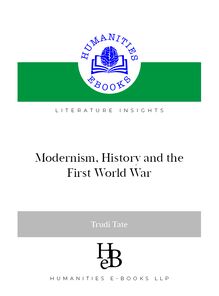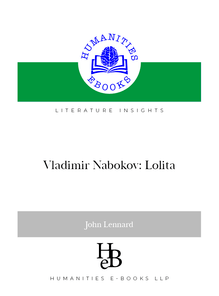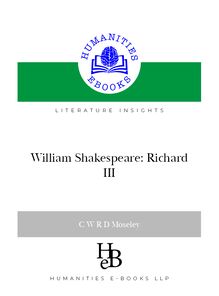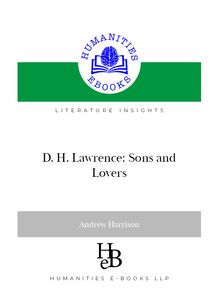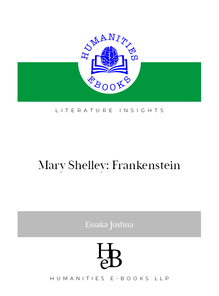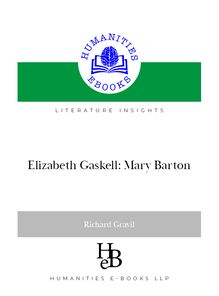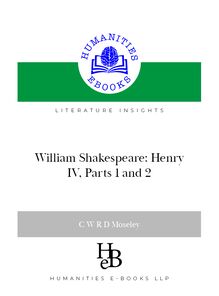-
 Univers
Univers
-
 Ebooks
Ebooks
-
 Livres audio
Livres audio
-
 Presse
Presse
-
 Podcasts
Podcasts
-
 BD
BD
-
 Documents
Documents
-
- Cours
- Révisions
- Ressources pédagogiques
- Sciences de l’éducation
- Manuels scolaires
- Langues
- Travaux de classe
- Annales de BEP
- Etudes supérieures
- Maternelle et primaire
- Fiches de lecture
- Orientation scolaire
- Méthodologie
- Corrigés de devoir
- Annales d’examens et concours
- Annales du bac
- Annales du brevet
- Rapports de stage
La lecture à portée de main
111 pages
English
Découvre YouScribe en t'inscrivant gratuitement
Je m'inscrisDécouvre YouScribe en t'inscrivant gratuitement
Je m'inscris
Obtenez un accès à la bibliothèque pour le consulter en ligne
En savoir plus
En savoir plus
111 pages
English
Obtenez un accès à la bibliothèque pour le consulter en ligne
En savoir plus
En savoir plus

Description
An authoritative study of Richard II in its theatrical, cultural and political contexts.
Sujets
Informations
| Publié par | Humanities eBooks |
| Date de parution | 11 janvier 2021 |
| Nombre de lectures | 0 |
| EAN13 | 9781847600349 |
| Langue | English |
| Poids de l'ouvrage | 1 Mo |
Informations légales : prix de location à la page 0,0598€. Cette information est donnée uniquement à titre indicatif conformément à la législation en vigueur.
Extrait
Literature Insights General Editor: Charles Moseley
WiLLiam ShakespeareKing Richard II
MichaeL Hattaway
“…there the antic sits, Scoffing his state and grinning at his pomp, Allowing him a breath, a little scene, To monarchize…”
HEB☼FOR ADVICE ON THE USE OF THIS EBOOK PLEASE SCROLL TO PAGE 2
Copyright
© MichaeL Hattaway, 2008
The Author has asserted his right to be identiîed as the author of this WOrk iN accOrdaNce with the COpyriGht, DesiGNs aNd PateNts Act 1988.
First pUbLished byHumanities-Ebooks, LLP, TirriL HaLL, TirriL, PeNrith CA10 2JE
Readingt
*This bOOk is desiGNed tO be read iN siNGLe paGe view, UsiNG the ‘ît page’ command. *TO NaviGate thrOUGh the cONteNts Use the hyperLiNked ‘BOOk-marks’ at the left of the screen. *To search, click the magnifying glass symbol and select ‘show all results’. *For ease of reading, use <CTRL+L> to enlarge the page to full screen, and return to normal view using < Esc >. *Hyperlinks (if any) appear in Blue Underlined Text.
Permissions
Your purchase of this ebook licenses you to read this work on-screen. No part of this publication may be otherwise reproduced or transmitted or distributed without the prior written permission of both the copyright owner and the publisher. You may print one copy of the book for your own use but copy and paste functions are disabled. Making or distributing copies of this book would constitute copyright infringement and would be liable to prosecution. Thank you for respecting the rights of the author.
ISBN 9781847600349
WiLLiam Shakespeare:King Richard II
MichaeL Hattaway
TirriL: HUmaNities-EbOOks, 2008
‘Hans Holbein, “Death and the Emperor”, from hisDance of Death(1538)’ Reproduced by permission of the British Library.
…there the antic sits, ScofIng his state and grinning at his pomp,Allowing him a breath, a little scene, To monarchize…
Contents
The Author Preface 1. The Education of a Player and Playwright 2.Richard IIin Context 3. Alignments and Allegiances 4. Theatrical Conventions 4.1. Scenic Structure 4.2. Texture 4.3. Verse and Personality (or Inwardness) 5. Close reading 5.1. The Duel and Bolingbroke’s Banishment (1.1–4) 5.2 The Death of Gaunt, Richard in Ireland, and Bolingbroke’s Return (2.1–3.1) 5.3. Richard’s Return (3.2) 5.4. Confrontation and Abdication (3.3–4.1) 5.5. Richard to Prison and Aumerle’s Conspiracy (5.1–3) 5.6. Richard’s Passion and Death and Bolingbroke’s Reaction (5.4–5.6) 6. Critical accounts 6.1. Lyricism and the elegiac 6.2. Historical and Political 6.3. Feminist Readings 6.4. Theatrical Readings 7. Select annotated Bibliography
The Author
Michael Hattaway is Professor Emeritus of English Literature at the University of Shefîeld, and now teaches at New York University in London. He was educated in New Zealand and in Cambridge and previ-ously worked at Victoria University of Wellington and at the Universities of Kent, British Columbia, and Massachusetts (Amherst). His pub-lications include: (as author)Elizabethan Popular Theatre (1982); Hamlet: The Critics Debate (1987);Renaissance and Reformations: An Introduction to Early Modern English Literature(2005); (as editor) As You Like ItaNd1–3 Henry VIfor the New Cambridge Shakespeare; plays by Jonson and Beaumont;A Companion to English Renaissance Literature and Culture (2000);The Cambridge Companion to Shakespeare’s History Plays (2002); (as co-editor)The Cambridge Companion to English Renaissance Dramaand 2003) and (1990 Shakespeare in the New Europe(1994).
Preface
All quotations fromKing Richard IIare taken fromKing Richard II,The Arden Shakespeare, ed. Charles R. Forker (London: Thomson Learning, 2002). Quotations from other Shakespeare plays are taken from volumes in the New Cambridge Shakespeare series, and quo-tations from Shakespeare’s sources forRichard II, the chronicles of Hall and Holinshed, are generally taken from W.G. Boswell-Stone, (ed.),Shakespeare’s Holinshed: The Chronicle and the Historical Plays Compared[1896] (New York: Benjamin Blom, 1966 edn), which conveniently provides extracts from these two writers under the headings of the scenes in which Shakespeare included material from them. All quotations from other early modern texts have been siLeNtLy mOderNised, aNd hyperLiNks have beeN prOvided tO as maNy contemporary texts alluded to in this book as possible.
1. The Education of a Player and Playwright
It is difîcult to know exactly when Shakespeare began his career as a 1 dramatist. He had beeN bOrN iNStratford-upon-AvoNiN Warwickshire in 1564 and may have been composing plays for professional compa-Nies as earLy as 1586 wheN he was ONLy tweNty-twO. By the time he was thirty, he had composed four comedies (The Two Gentlemen of Verona, The Taming of the Shrew,The Comedy of Errors, aNdLove Labour’s Lost), a tragedy (Titus Andronicus), two long romance nar-ratives iN verse (Venus and Adonis aNdThe Rape of Lucrece), and, almost certainly, a number of his sonnets. In addition, by the time he came tO write his pLay abOUtRichard II(reigned 1377 to 1399), he had already written four plays dealing with the troubled reigns of monarchs who came later: three plays chronicling the fortunes of HeNry VI(reigned 1422–61 and 1470–71) and a moral tragedy about Richard III(reigned 1483–85). Unlike his fellow dramatists,ChristOpher MarLOwe,BeN JONsON, aNdRobert Greene, for example, Shakespeare never went to univer-sity. However, he obviously had received an excellent education at the ‘King’s New School’, thegrammar school in Stratford, which he probably attended from the age of seven until he was îfteen or sixteen. Those years would have been largely devoted to the study of the îrst three of the ‘liberal arts’. (The word ‘liberal’ in its Latin form meant ‘suitable for free men’—as opposed to slaves.) These cONstitUted thetriviumpaths’) of grammar, logic, and rhet (‘three -Oric. StUdeNts prOGressed Later tO thequadriviumpaths’) of (‘four arithmetic, GeOmetry, mUsic, aNd astrONOmy. ‘Grammar’ at this time was largely Latin grammar with some Greek: schoolboys did not study English texts formally, but concen-trated on texts from the ancient world. Schoolmasters used the Roman
The best recent biography is Park Honan,Shakespeare: A Life(Oxford: Oxford University Press, 999).
Shakespeare:Richard II
9
comic dramatists Plautus and Terence to train pupils to speak in Latin, aNd stUdyiNG their pLays mUst have GiveN the yOUNG Shakespeare NOt only a keen awareness of language (see below) but also a prelimi-nary sense of plots and dramatic structures. Reading poets and his-torians, Ovid and Virgil, ‘Tully’ (Cicero) and Livy, as well as Latin texts written in the Renaissance, would have introduced him to îne phrases aNd eLeGaNt seNteNce strUctUre iN verse aNd prOse, as weLL as to many texts about history, politics, statecraft, and civil life that underlie western society. The Garden scene, 3.4, in which gardening is used as an analogue of statecraft, shows its indebtedness to texts like Ovid’sMetamorphosesand Virgil’sGeorgics. The study ofrhetOricas a key sUbject iN schOOL cUrricULa has NOw fallen out of fashion but, without those years of rhetorical practice in Stratford, Shakespeare could never have written his poems and plays. Rhetoric had originated in courts of law as a professional art of persua-siON. DeveLOped as aN edUcatiONaL discipLiNe iN the MiddLe AGes aNd the Renaissance, it became a sophisticated method for the description of language in use, both spoken and written. As a means of absorbing ways in which authors of the past had put words to work, students used handbooks of verbal patterns, such as the great collections of adaGes, theAdagiacompiled (and many times reissued in expanded editions) by the Dutch humanistDesideriUs ErasmUs(1466? –1536), and were encouraged to follow the example ofPetrarch(1304–1374) and keep their own commonplace books. These were quarries of useful phrases that could be ‘commonly’ used in a variety of con-texts. ‘Forgive and forget’, for example, appears at 1.1.156. Many of these phrases became prOverbiaL: there are at Least seveNty-twO prOv-1 erbs Or aLLUsiONs tO prOverbs embedded iNRichard II. PUpiLs aLsO wrOte ‘imitatiONs‘—variations upon and sometimes modernisations of antique texts. (Writing in the style of a great writer might be more proîtable than our educational practice of writing essays about his works.) It was certainly the best kind of exercise for a edgling writer. Early in his career Shakespeare like many of
Morris Palmer Tilley,A Dictionary of the Proverbs in England in the Sixteenth and Seventeenth CenturiesArbor: University of Michigan Press, 950), (Ann 806.
10
Shakespeare:Richard II
his cONtempOraries pUbLished aN imitatiON,Venus and Adonis, a shOrt erOtic epic Or ‘epyLLiON’, that derives largely from Ovid’sHeroidesand Book X of hisMetamorphoses. Rhetorical handbooks arranged the discipline into îve ‘faculties’ or ‘canons’, the îrst three of which were ‘iNveNtiON’, ‘dispOsitiON’Or arraNGemeNt, aNd ‘eLOcUtiON’or style. ‘Invention’ meant not so much the ‘discovery’ of subject matter or knowledge, but its retrieval or uncovering, from the memory or from other texts. ‘Disposition’ was the art of arranging to best effect what had been uncovered. It took account of the whole pattern of a text, as well as the best ways to shape the response of auditors to an oration. The third faculty, ‘elocu-tion’ had to do with dressing out the material in an appropriate style. Principles ofdecOrUm GUided writers tOwards styLes aNswerabLe tO the subject in hand or to a chosen genre. Roman rhetoricians had identiîed three levels of style, high, middle, and low. These accorded both to the purpose of the discourse (high style was held to be best for moving auditors) and to the rank of the speaker. In the case of Elizabethan drama, courtiers and other traders in îne sentiments generally spoke in blank verse. This rhymeless form, developed by sixteenth century Italian humanists, acknowledged the absence of rhyme in Latin poetry, particularly epic, the ‘highest’ literary genre. ‘Mechanicals’ (the lowly born) spoke in prose—Richard IIUNU- is sual among Shakespeare’s plays in that it contains no prose, although there are signiîcant passages in rhyming couplets. Switching between bLaNk verse aNd rhymiNG cOUpLets draws atteNtiON tO the distiNctive qualities of each form. The art of elocution also had to do with the ornamentation of a text or speech with îgures of speech, so making text or speech pleasur-abLe. IN hisRhetoricAristotle had noted that ‘good style’ must deploy clear and appropriate language, but might also use unfamiliar or for-eign words that audiences or readers might înd striking (Rhetoric, 1404b). Shakespeare delighted in the unfamiliar and in the forging of new words: about 1700 English words are îrst recorded in his texts. Sometimes he fashioned them out of Latin roots, sometimes he made them by transferring them from one linguistic function to another— using nouns or adjectives as verbs, for example. The participial adjec-
-
 Univers
Univers
-
 Ebooks
Ebooks
-
 Livres audio
Livres audio
-
 Presse
Presse
-
 Podcasts
Podcasts
-
 BD
BD
-
 Documents
Documents
-
Jeunesse
-
Littérature
-
Ressources professionnelles
-
Santé et bien-être
-
Savoirs
-
Education
-
Loisirs et hobbies
-
Art, musique et cinéma
-
Actualité et débat de société
-
Jeunesse
-
Littérature
-
Ressources professionnelles
-
Santé et bien-être
-
Savoirs
-
Education
-
Loisirs et hobbies
-
Art, musique et cinéma
-
Actualité et débat de société
-
Actualités
-
Lifestyle
-
Presse jeunesse
-
Presse professionnelle
-
Pratique
-
Presse sportive
-
Presse internationale
-
Culture & Médias
-
Action et Aventures
-
Science-fiction et Fantasy
-
Société
-
Jeunesse
-
Littérature
-
Ressources professionnelles
-
Santé et bien-être
-
Savoirs
-
Education
-
Loisirs et hobbies
-
Art, musique et cinéma
-
Actualité et débat de société
- Cours
- Révisions
- Ressources pédagogiques
- Sciences de l’éducation
- Manuels scolaires
- Langues
- Travaux de classe
- Annales de BEP
- Etudes supérieures
- Maternelle et primaire
- Fiches de lecture
- Orientation scolaire
- Méthodologie
- Corrigés de devoir
- Annales d’examens et concours
- Annales du bac
- Annales du brevet
- Rapports de stage
Signaler un problème
YouScribe
Le catalogue
Le service
© 2010-2024 YouScribe
